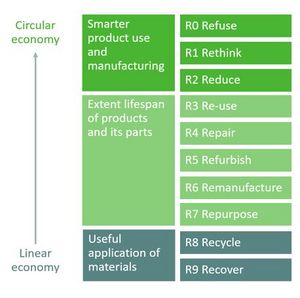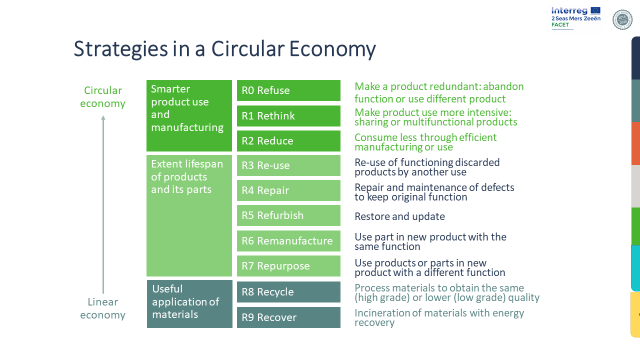Geen bewerkingssamenvatting |
Geen bewerkingssamenvatting |
||
| (22 tussenliggende versies door 3 gebruikers niet weergegeven) | |||
| Regel 1: | Regel 1: | ||
=== Implementing CE-solutions: the 9R-strategies | <div class="mw-btn mw-btn-l mw-btn-primary d-ib"> {{External link|resource=Resource Hyperlink 01123|name=Request the Toolkit|dialog=process-linkwebsite-dialog}}</div> | ||
== Implementing CE-solutions: the 9R-strategies == | |||
Several circularity strategies exist to reduce the consumption of natural resources and materials, and minimise the production of waste. They can be ordered for priority according to their levels of circularity. | Several circularity strategies exist to reduce the consumption of natural resources and materials, and minimise the production of waste. They can be ordered for priority according to their levels of circularity. | ||
| Regel 6: | Regel 8: | ||
There exists a hierarchy of circularity strategies, different levels to reduce the consumption of natural resources and materials, and minimize the production of waste<sup>[1]</sup>. They can be ordered for priority according to their levels of circularity (Figure 1). | There exists a hierarchy of circularity strategies, different levels to reduce the consumption of natural resources and materials, and minimize the production of waste<sup>[1]</sup>. They can be ordered for priority according to their levels of circularity (Figure 1). | ||
==== More information and examples with regards to these 9R-strategies can be found in the toolkit. ==== | |||
Within the FACET-project these circularity strategies are linked to the concept of value chains to make them more tangible. | |||
[[Bestand:9_R_strategies.JPG|kaderloos]] | |||
==== References ==== | ==== References ==== | ||
[1] Figure: Potting, José, et al. Circular economy: measuring innovation in the product chain. No. 2544. PBL Publishers, 2017. | [1] Figure: Potting, José, et al. Circular economy: measuring innovation in the product chain. No. 2544. PBL Publishers, 2017. | ||
{{Project FACET Tool config}} | {{Project FACET Tool config}} | ||
{{Project | {{Project | ||
|Name=9R-strategies explained | |Name=9R-strategies explained | ||
| Regel 35: | Regel 37: | ||
|Show title=Nee | |Show title=Nee | ||
}} | }} | ||
{{Project FACET Tool additional | {{Project FACET Tool additional | ||
|Type=Theory | |Type=Theory | ||
Huidige versie van 19 sep 2024 om 14:53
Implementing CE-solutions: the 9R-strategies
Several circularity strategies exist to reduce the consumption of natural resources and materials, and minimise the production of waste. They can be ordered for priority according to their levels of circularity.
Ideally, all materials stay within the economic production and consumption system. As a rule of thumb, more circularity equals more environmental benefits. This ultimate circularity, in which a product chain is closed because the materials can be applied over and over again, while retaining their original quality. If these can be applied in a similar product while no additional natural resources are necessary, then waste is a concept of the past. However, this is very hard to achieve in reality and full circularity is therefore the highest level, or objective within a Circular Economy.
There exists a hierarchy of circularity strategies, different levels to reduce the consumption of natural resources and materials, and minimize the production of waste[1]. They can be ordered for priority according to their levels of circularity (Figure 1).
More information and examples with regards to these 9R-strategies can be found in the toolkit.
Within the FACET-project these circularity strategies are linked to the concept of value chains to make them more tangible.
References
[1] Figure: Potting, José, et al. Circular economy: measuring innovation in the product chain. No. 2544. PBL Publishers, 2017.


